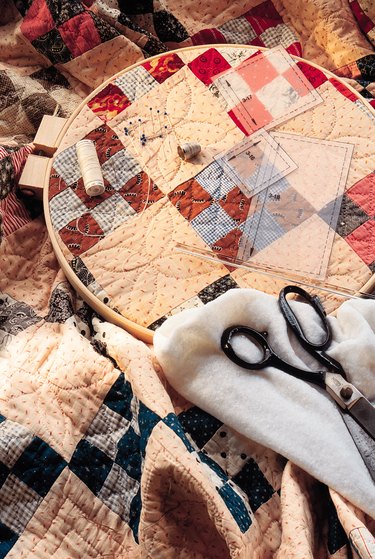Things You'll Need
Clean, dry, white hand towels
Non-acetone polish remover
Cotton balls
Plastic scraper
Gentle detergent (optional)

Don't despair when your handmade, brightly colored quilt flaunts a luminous nail polish stain after last night's slumber party. Nail polish may be one of the hardest fabric stains to treat, but it is possible to remove. If left to dry, polish takes more time to remove, but do not let a sense of urgency lead to an irreversible mistake. If you're unsure about how you're cleaning solution will affect the quilt fabric, take time to test a small, hidden spot on the quilt so you can make an informed decision about whether to remove the polish or leave alone and call it gently-loved family heirloom.
Step 1
Gently scrape any dried polish from the quilt with the blunt end of a knife or a plastic scraper taking care not to tear or damage the fabric. It is easier to remove nail polish before it dries and sets, but if it has, take advantage of the scrape method to remove any polish that pooled above the fabric
Video of the Day
Step 2
Determine what type of fabric was affected. Many quilts are made from cottons or flannels and polish remover can be used to spot treat fabrics if done with care. Do not use polish remover on synthetic fabrics including acetate, triacetate or modacrylic fabrics. The acetone remover may dissolve these materials. If you are unsure what material was used in your quilt, consider taking it to a professional dry cleaner for help with identification. For unique fabrics, including rayon or acetate based fabrics, consider having the quilt professionally cleaned.
Step 3
Test the quilt fabric for colorfastness. If you have never polish remover on the quilt, test a little on a seam, or on the inner side of the quilt. Make sure the remover does not affect the color of the fabric or damage it in anyway. Wait several minutes until the fabric dries to fully judge if its safe. If the acetate fades the fabrics color, determine if the result is worth the effort of removing the polish.
Step 4
Place the quilt on a flat, protected surface. Place a clean, dry towel underneath the damaged section of quilt to soak up any excess moisture. Choose a white or colorless towel to prevent any color exchange.
Step 5
Use a cotton ball soaked with a small amount of acetone polish remover to the stain. Blot excess nail polish with a clean, disposable cloth or a paper towel. Blot the spot dry and repeat until the all the polish is removed. Depending on the size of the stain and how long its been in the fabric, you may have to repeat this step many times.
Step 6
Wash the quilt with a gentle detergent in the gentle cycle of your washing machine. This step is completely up to the quilt owner. Some like the soft, fluffy feel of a freshly laundered quilt and if it's fairly new, and if the fabric was pre-washed, then it should hold up well in the gentle wash cycle, and on low in the dryer. However, it the quilt is vintage, or more of a work of art than a love-worn comforter, just spot clean with acetone and let the quilt air out until the smell dissipates.
Tip
Acetone polish remover works best on fabrics because it is less oily than non-acetone remover.
For patchwork quilts with severe nail polish splatters, consider replacing the soiled patch with a new piece of cotton or flannel.
Warning
Keep polish remover and all other stain removing chemicals on a high shelf out of children's reach.
Use nail polish remover in a well-ventilated room.
Video of the Day